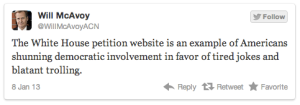By now pretty much everyone (especially anyone who might stumble across this blog) has read about the White House’s official and hilarious answer to the We The People petition to build a Death Star, but it really is more than a hilarious gag. Amusing or entertaining forms of engagement can do more than draw eyeballs or clicks. Rather than simply being an instance of “White House Staffers: They’re just like us!” wherein we learn that pols are Real Humans who understand humor, they should also be seen as a productive part of democratic culture. They have the potential to engage people more deeply, and in ways that matter, but are less immediate (or immediately measurable than campaigns or governments often like. Fun can be productive for civic life.
When the deluge of anti-administration petitions occurred just after Obama’s reelection, Micah Sifry said it could “form a more perfect union,” by engaging in legitimate deliberation that takes seriously disagreeing factions. While I definitely agree with the argument that affordances like message boards and social discussion would make WTP more legitimately democratic and deliberative, Sifry’s stance rings true. The more communication that is present, the better off we all are. Little-d democracy at its simplest.
In light of the both comedic and implausible topics that often crop up on WTP—Death Stars, beer recipes, secession. . . and Change.org has fallen to this same problem–people have grown skeptical. When the gimmicks become the story, it provides ample opportunity for criticism: WTP has become ridiculous, is a joke. TV characters on Twitter are even more harsh:
Sure, in these cases, the site isn’t living up to it’s grand claim to lead directly to more accountability or openness…but nor is it failing to produce productive engagement. Fun can be effective; inefficiencies can be meaningful.
First of all, by asking people to petition, WTP constructs an image of a good citizen as one who talks back to their government, makes requests, and solicits others within their community to join causes (no matter how silly they seem). This incredibly active citizen is a big step up from just hoping your citizens are informed, and gives important insight into what it means to be a citizen in a digital world. It’s Like Clay Shirky has argued, lolcats –> democracy.
More broadly, us folks in the Engagement Game Lab (eric’s piece) have been talking about meaningful ineffeciencies a lot. Taking planning decisions out of hours of meetings and turning them into month-long games, creating alternate realities within which to teach citizenship, and layering social reputation systems onto existing service-delivery apps are all projects we’re working on…Our hypotheses are that these fun, silly, and allegedly “inefficient” accouterments can actually better teach citizens that their input matters, lead to longer-term retention of civic information, increase feelings of collective efficacy and social cohesion (important markers for other engagement measures). Most importantly, they can create an environment in which citizens can legitimately interact with governments and with one another.
While WTP may not be the most interactive, that it’s inviting and open (and still forces some level of interaction) makes it an interesting site for beginning to legitimately think about the connection between fun and meaningful. (And hopefully in a few months, we’ll have the data do more than consider this connection!)

The death star would have been the ultimate meaningful inefficiency. However, after decades of construction and gagillions of dollars, we should figure out a way to avoid silly little vulnerabilities like the entire thing blowing up because of a single blaster shot from an x-wing.